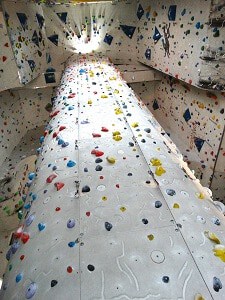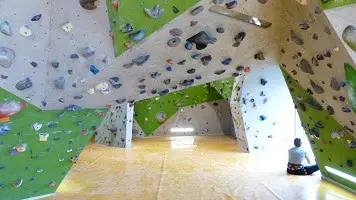Disclosure: Links marked with * are Affiliate Links. As an Amazon Associate, I earn from qualifying purchases if you decide to make a purchase through these links – at no cost for you!
Climbing is a full body workout and can be very strenuous. Climbing a wall requires a lot of strength, endurance, technique, persistence and above all grip strength. For beginners, even a slow pace is demanding. People new to climbing notice muscles the next day they never knew before. But how many calories do you actually burn when climbing? Climbing burns as many calories as breaststroke swimming.
Women use about 350 kilocalories per hour (kcal/h) and men about 450 at a normal speed while climbing.
Normal speed means that you pause for a few seconds during climbing either to put new chalk on your hands or to plan the next steps or holds. If you know the route, don’t have to apply chalk in between and keep up a slightly faster pace, you can also use up to 600 kcal/h!
In this article, I will calculate exactly how many calories you burn while climbing, tell you why I think climbing is the ultimate full-body workout and give you a few tips on how to make climbing a targeted workout.

Exact Calculation of Calories Burned while Rock Climbing
As I said, climbing is a full-body sport. Especially the muscles of arms, shoulders, back, and legs are used. In addition to these muscles and general endurance, many tendons and ligaments are also needed. Since you use many parts of your body that you don’t need that often when climbing, it is advisable not to overdo it at the beginning and to stop before damage or overstraining occurs.
I have often seen newcomers to climbing need a two-week break after their first climb to fully regenerate. If you have overcome this first hurdle and have already climbed 2-3 times, you have reached a normal speed.
To calculate the calories burned during rock climbing, we need our individual basal metabolic rate and multiply it by the so-called PAL factor which is a value for the intensity of a certain activity.
Basal Metabolic Rate
Our body needs a certain amount of energy every day to maintain its vital functions (breathing, blood supply, etc.). Obviously, this basal metabolic rate differs depending on how old, heavy and tall you are and to which sex you belong.
Here are the two formulas for women and men:
| Gender | Basal Metabolic Rate [kcal per day] |
|---|---|
| Male | 66,5 + 13,7 * kg + 5 * cm – 6,8 * y |
| Female | 655 + 9,6 * kg + 1,8 * cm – 4,7 * y |
Where kg is the weight in kilograms, cm is the height in cm and y is the age in years.
For a man weighing 80 kg, 180 cm tall and 25 years old, the basal metabolic rate is 1892.5 kcal per day. For a woman weighing 65 kg, 165 cm tall and 25 years old, the basal metabolic rate is 1468.5 kcal per day. Of course, these numbers only apply if we lie around all day and don’t make much mental effort.
To calculate the energy consumed, we now only need the PAL factor.
PAL Factor
The PAL factor (Physical Activity Level) is a measure of physical activity. It has to be multiplied by the basal metabolic rate. If you work mainly at a desk and do no sport, the PAL factor is about 1.5. For demanding jobs or active athletes, the PAL factor is 2 to 2.5.
This factor can also be used for certain sports. The assumption is that you would do this sport all day long. For climbing the PAL factor is 6 (for comparison: jogging 7, hiking 4). Since we don’t climb the whole day, we have to divide the result by 24 to get the total energy consumption per hour. In our example, this would be 1893 * 6 / 24 = 473 kcal/h for the man and about 367 kcal/h for the woman.
Is Rock Climbing the Ultimate Full Body Workout?
Sport revolves around activating muscles and letting them work. Few sports do this as well and in such a diversified way as rock climbing. In order to hold on to the wall, a lot of muscles are constantly under tension. Even the legs are needed for stabilization and for pushing up (beginners are often surprised how much you need your legs).
The ideal thing about climbing is that we are constantly changing our position and the muscles are therefore always stressed differently. And then there is the stretch we feel when we want to reach for a far away hold.
Climbing with rope on a wall as well as bouldering (climbing without rope near the ground which is padded with sports mats) requires almost all muscles in the body. This makes climbing one of the more complex movement sequences, unlike, for example, running or repetitive movements in the gym. And since no route in a climbing hall and no rock outdoors are the same, two climbing sessions are never as similar as two workouts in other sports. Because of this high variety and the activation of muscle parts, which are not used normally, climbing brings a very high-calorie consumption.
Besides muscle training, climbing is also an excellent endurance sport. As long as you don’t stop all the time during climbing and take a break, climbing is about as strenuous as swimming.
Three Workout Ideas for Rock Climbing
Endurance Training by Rope Climbing

There are many ways in which we can train our bodies while climbing. Depending on which route you choose or how long you climb, it affects which muscles you use and how hard you use them. If we choose a technically easy route with few parts that require a lot of strength but climb over a long distance, we need a lot of endurance.
In most cases, the cardiovascular system is hardly activated properly on short but strenuous stretches. Only if we workout longer, we develop our stamina and stimulate the development of lean, strong muscles.
As a beginner, you first have to train the muscles that are not yet ready to hold our body on the wall for a long time. Such a full body endurance training will only be possible when all the muscles required for climbing are equally exercised.
Strength and Endurance by Bouldering

Bouldering is ingenious as training. I love bouldering. You don’t need a climbing partner to belay and you can train your technique, strength and endurance. Bouldering is usually a little more strenuous than normal rope climbing. But you climb much shorter distances. The characteristics of a High-Intensity Interval Training (HIIT) are both exhausting and short.
HIIT improves strength endurance, lactate tolerance (when muscles become sour), lactate loss (how quickly muscle soreness is reduced), speed endurance and maximum oxygen intake.
Normally the HIIT is used in running. But we can also use this effective training method for climbing.
When bouldering, choose routes that really make you sweat. It is ideal if you reach 80-90% of your maximum heart rate (maximum heart rate = 220 – age). You won’t last very long. Between these sprint phases, you should take a break of about three to five minutes. However, you should make sure that you still move. It’s best to walk around a bit and find the next route.
Strength Training for Pros with the Hangboard
Some of you may have seen a hangboard or fingerboard in your climbing hall. As a beginner, you have no chance to hold on to it at all. Hangboards are mainly for experienced climbers who want to improve their grip strength.
If you want to train your grip for rock climbing, take a look at this article in which I present different training methods including a hangboard training.
In principle, a hangboard is a board with holes, edges and grips of different sizes and depths that you hold on to in order to train grip strength. The smaller these holds are, the harder it is to hold on to them. The training consists of holding on to these grips until just before our muscles fail. The difficulty is of course increased by using more difficult holds.
If you can hold on to even the smallest holds for more than 12 seconds, you can hang weights on your harness. But it is especially here that maximum attention is required. Once you realize something feels weird, you should stop right there.
Conclusion
Climbing is an excellent full-body workout and burns a lot of calories. About 350 kcal/h for women and 450 kcal/h for men.
The high variety of climbing exercises a large part of your body and trains endurance, strength, speed, coordination, balance and much more.
Depending on how technically demanding a route is, how much strength it takes and how long the route is, we can dynamically shift the focus between strength and endurance. Difficult but short distances in bouldering are excellent for building up strength. Long distances in rope climbing improve your endurance.
For athletes from other sports, too, climbing can be integrated into the training in order to benefit from the full-body workout.
Attention: You have to take care of your safety when climbing! The information on climbtheearth.com only helps you to learn. Before you climb, you should make sure that you have been properly instructed by an expert and that you follow all safety precautions.
Disclosure: This website is the property of Martin Lütkemeyer and is operated by Martin Lütkemeyer. Martin Lütkemeyer is a member of the Amazon Services LLC Affiliate Program, an affiliate advertising program designed to enable Web sites to earn advertising revenue through advertising and linking to Amazon.com. Links marked with * are affiliate links.
